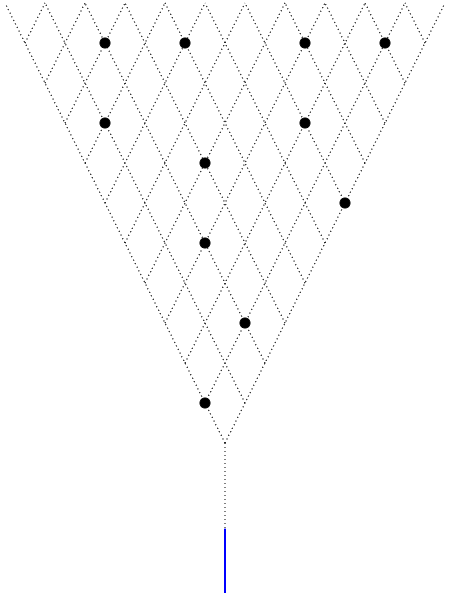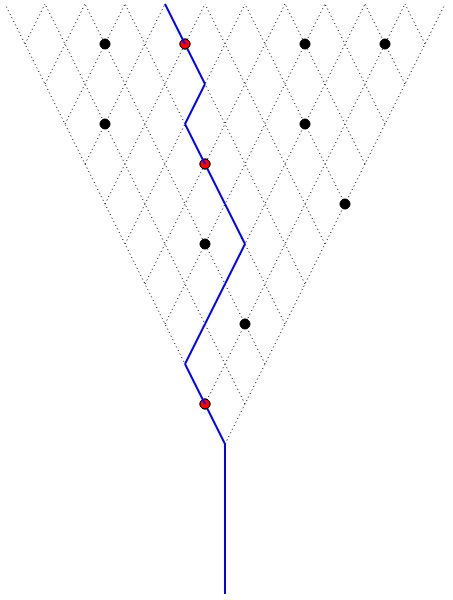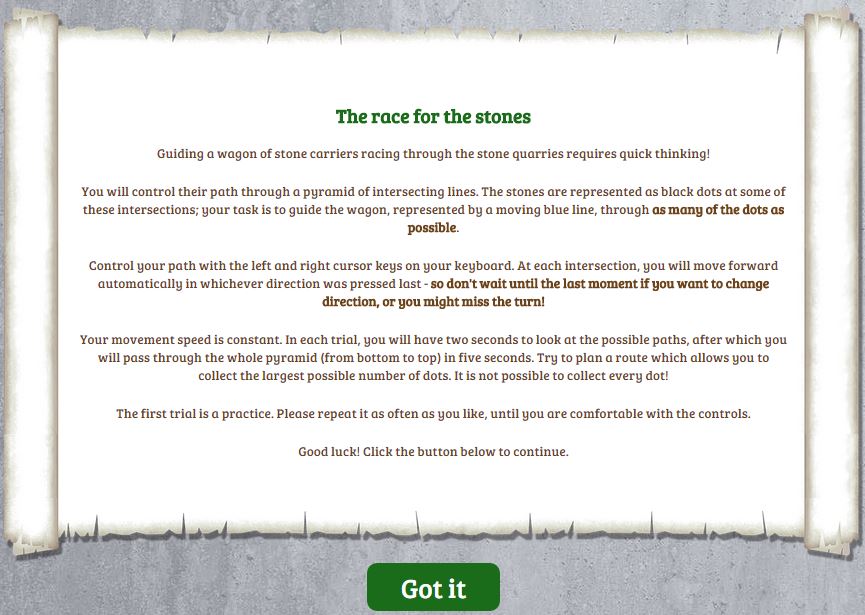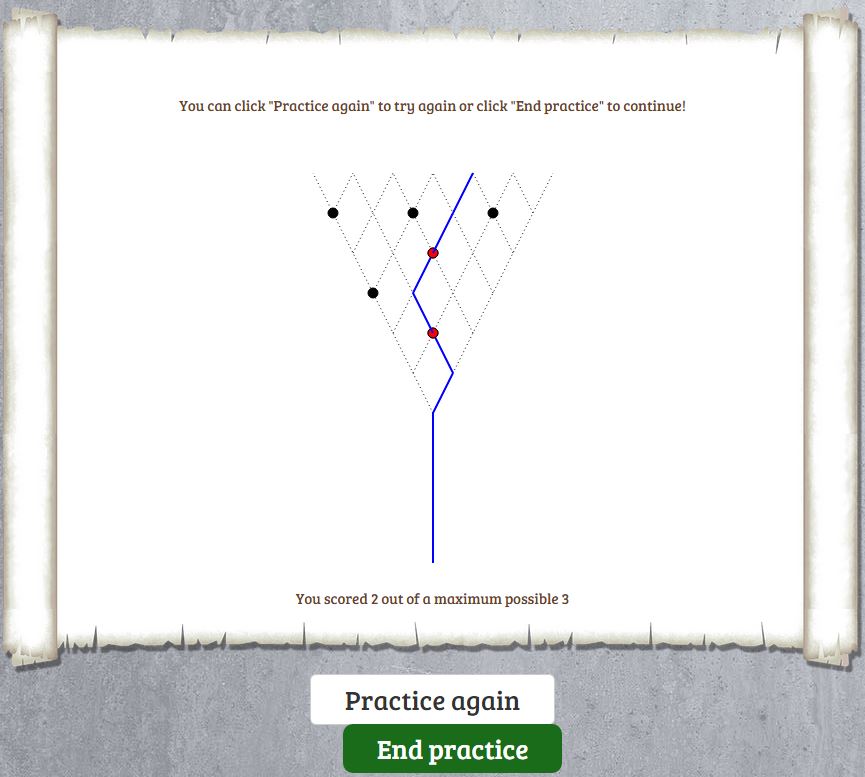Description
In the web presentation, the Elithorn Mazes test was introduced to twins as an activity called "The race for the stones", with the following text: "The Keep is indeed magnificent! Now our stronghold can be enriched by the presence of distinguished scholars and musicians but we need more stones to build housing for our expanding community! We have just one team of stone carriers available - your task is to guide them through as many stone quarries as possible, before we are forced to turn away travellers to face a road which grows more dangerous with every passing day. Will you accept the challenge of the stone carriers?" This text was accompanied by the image below:

The test itself consisted of a practice item followed by 10 scored test items. Each item involved a moving image with which a twin was asked to interact by means of the computer keyboard. The initial image for each item comprised an inverted triangular grid, with circular black dots or "stones" placed in an irregular pattern at junctions of the grid (see the practice item illustrated below). On starting each item, after a 2 second pause, a moving solid line would appear from the bottom of the image, travelling upwards along the dotted grid lines. By default, this line would take the initial branch to the right then would keep moving in a straight line until it reached the top of the image. The line took roughly 5 seconds to move from bottom to top of the image. Twins were asked to change the direction of movement of the line by pressing the left and right arrow keys on their computer keyboard. The aim was to direct the line to pass through as many of the "stones" as possible. The score gained for each item depended on the number of "stones" that the line had passed through.
The test was preceded by an instructions page, which is reproduced here:
The instructions page was followed by a single practice item. The practice
item was optional: a twin could skip the practice item, attempt it once, or
attempt it many times if they wished. On each attempt of the practice item, the
twin was presented with feedback giving a mark for their response. No such
feedback was given after the main test items. No data for the practice item is
included in the dataset. The practice item is reproduced here (with an example
response), illustrating the nature of the test items in general.
In this example response, 2 stones have been crossed (shown in red) from a maximum
achievable of 3 stones in the practice item.
Twins had no control over the speed with which the line moved upwards on the image; they could only control the direction of movement of the line as it reached each junction on the image grid. Hence, there was an effective time limit of roughly 7 seconds for each item: the initial 2 seconds before the line appeared, plus the 5 seconds that the line took to travel from bottom to top of the image. It was possible for a twin effectively to "time out" on an item by failing to provide any meaningful keyboard input, in which case the line would follow its default path.
The 10 main test items followed immediately after the practice item. The items were presented in numerical item number order, without any branching or discontinue rules. There was no pause or "next item" screen in between items. Once the first main test item had started, the 10 items followed one after the other automatically without pause. Hence, it was possible for a series of test items to "time out" without any input from a twin.
The score for each item was a decimal number between 0 and 1, depending on the number of "stones" through which the line had passed (relative to the maximum possible for the given item). A full table of test items, including initial stimulus images, can be found below under the heading Table of Test Items.
Twins were encouraged to complete the test in one session. Hence, no "come back later" button was placed on screen at any stage. As described above, it was not possible to pause between items in this test. However, it was possible to halt a test, by closing the browser or turning off the computer. After halting the test, it was possible for a twin to resume at a later time or date by logging in again: they would be presented with the next item to be attempted.
An individual test item could be compromised by an interruption after the item had started and before it had ended. Interruptions might result from twin actions such as closing the browser, or clicking the browser's back or refresh buttons. Interruptions might also be caused by random events such as computer crash or loss of internet connection. The effect of interruption was to forfeit the item with zero score. On logging in at a later time after an interrupted item, a twin would be presented with the following item of the test.
Web Test Rules
- Scoring
For each of the 10 items, a decimal score between 0 and 1 is given. The item score represents the number of stones that the twin's line passed through, expressed as a fraction of the maximum possible number of stones that could have been passed through in that item. The practice item does not contribute to the scoring. The maximum total score for the test is 10. - Timeout rule
As explained above, the line moved at a fixed speed, giving a twin a total of roughly 7 seconds to respond to each item. Twins had to respond in real time while the line was moving across the image. Failure to respond (no keyboard presses registered) would result in a default response being recorded for the item; such default responses were recoded as timeouts in the item data.
Dataset Item Variables
The item variables relating to this test, as listed in the table below, were generated automatically by programs on the web server. For the sake of completeness, the table also lists derived variables relating directly to this test (rckemdata1/2, rckemstat1/2, rckemtime1/2, rckemXXan1/2). Note that the dataset only includes data for completed tests. If a twin started the test but left it unfinished, then the data for that test were deleted from the dataset.
The raw item response variables contained complex strings representing the path followed by the line on the screen. In the dataset, these have been replaced by much simpler categorised item response variables as shown in the table.
Note that the item response variables have also been recoded where appropriate with values -1, -2 and -4 to denote item timeout (without response), discontinued or interrupted respectively. See the web data cleaning page for further details.
Raw item response time variables have been dropped from the dataset, as these were effectively constant (roughly 7 seconds for each twin in each item). The start and end dates/times have not been retained in the dataset.
| Variables | Explanation | Values |
|---|---|---|
| rckemdata1/2 | Data flag: are test data present? [DERIVED VARIABLE] | 0=no, 1=yes |
| rckemstat1/2 | Test status: was the test completed? [DERIVED VARIABLE] | 0=not started, 1=started but not finished, 2=finished successfully, 3=compromised by loss of data, 4=compromised by random responses |
| rckemsttm1/2 | Start date and time of the test [not in dataset] | Date-time values |
| rckementm1/2 | End date and time of the test [not in dataset] | Date-time values |
| rckemtime1/2 | Time interval from start to end of the test [DERIVED VARIABLE] | Minutes (decimal values) |
| rckemXXan1/2 | Test item response category for item XX* [DERIVED VARIABLE] |
1=some keyboard input but zero score, 2=some keyboard input with non-zero score, -1=no keyboard input (effectively timed out), -4=item interrupted |
| rckemXXsc1/2 | Test item score for item XX* | 0 to 1 (decimal values) |
| rckemtot1/2 | Test total score: total score for all 10 items | 0 to 10 (decimal values) |
| rckemtotp1/2 | Test total score expressed as a percentage | 0 to 100 (decimal values) |
* XX denotes the item number, 01 to 10
Table of Test Items
The 10 main test items are tabulated below, in each case showing:
- The item number
- The maximum number of "stones" (black dots) that the line could pass through, resulting in a maximum score of 1
- The initial stimulus: an image of the grid just after it appeared on screen, with the blue line appearing at the bottom
- A sample response in the form of an image of the completed item (not necessarily with maximum score), with a caption showing the number of "stones" crossed and hence the item score
Note that generally there were several possible routes through the grid that would cross the maximum number of stones and hence achieve the maximum score for the given item.
The practice item is not included below, because it has already been depicted (see test description above).
Item 1
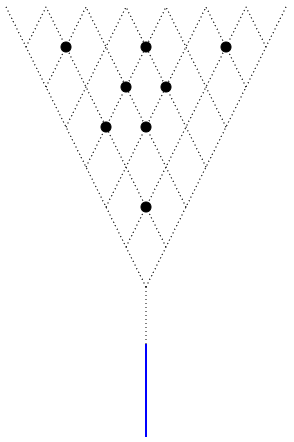
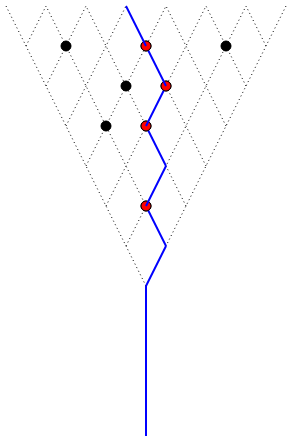
Item 2
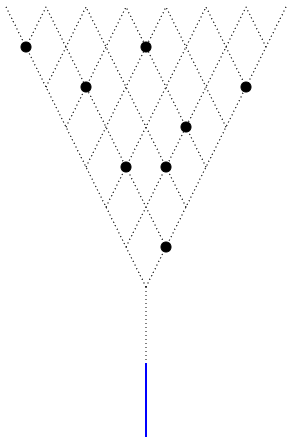
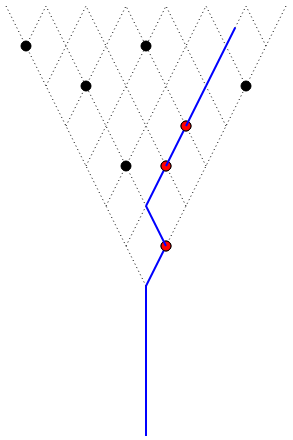
Item 3
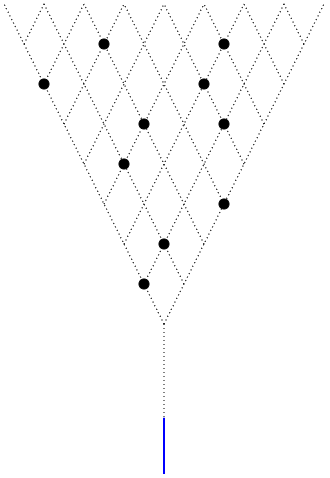
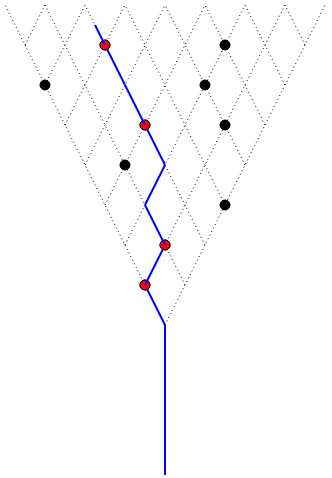
Item 4
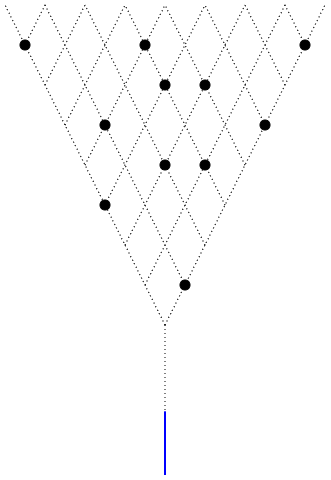
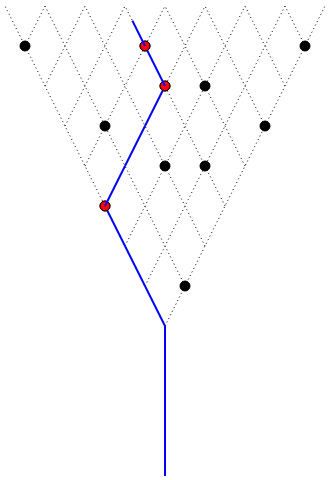
Item 5
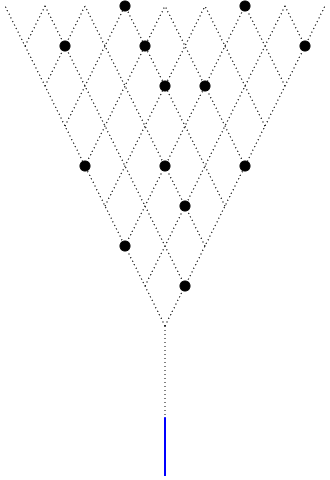
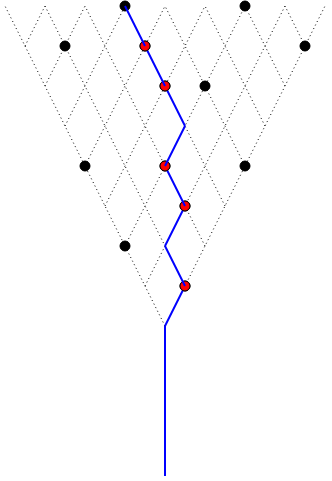
Item 6
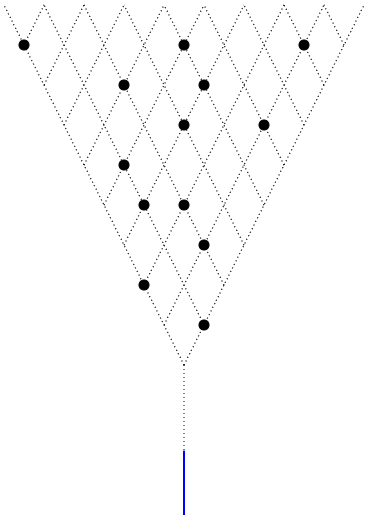
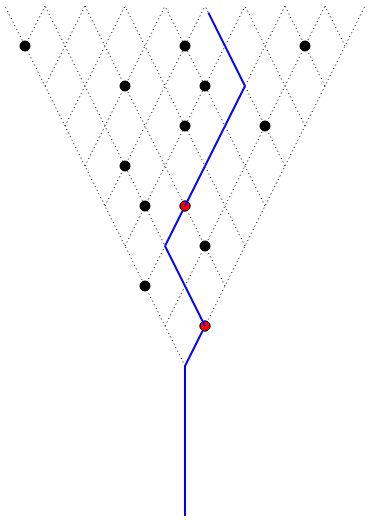
Item 7
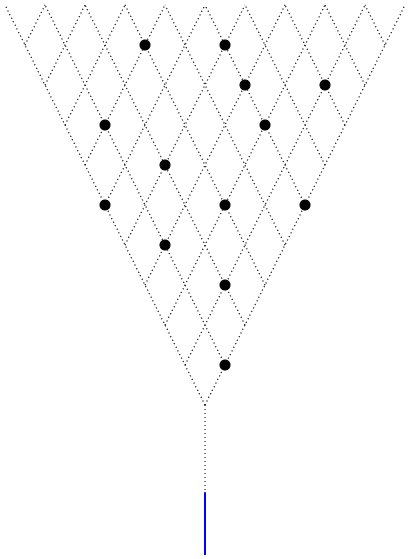
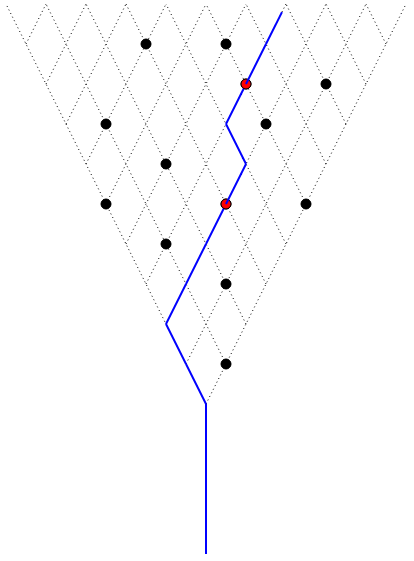
Item 8
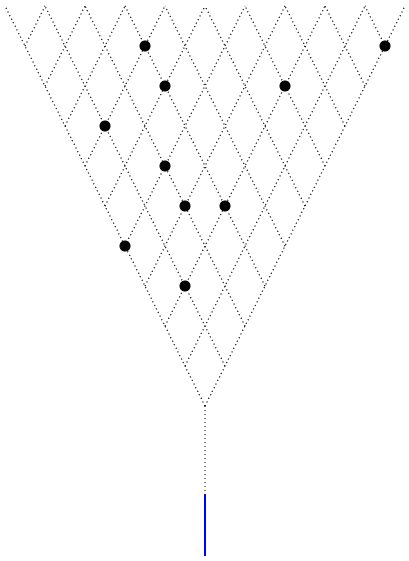
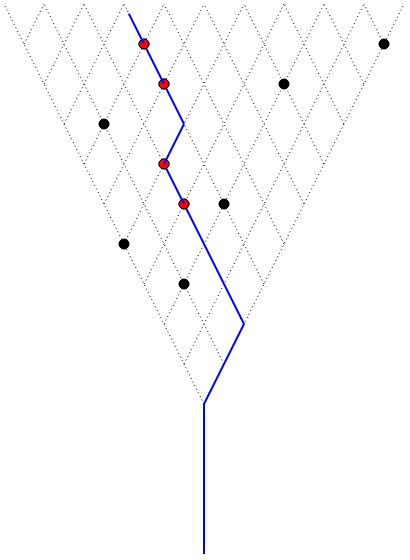
Item 9
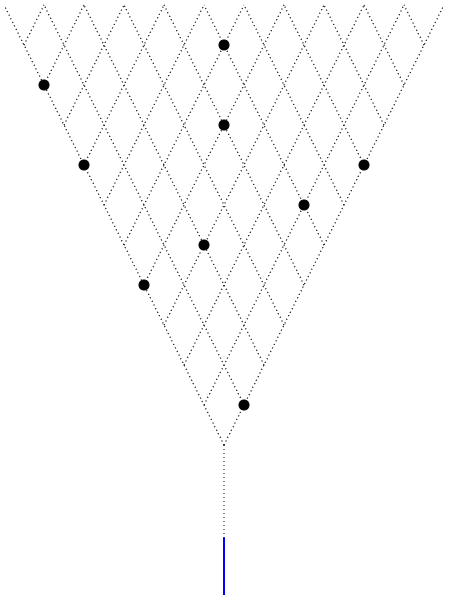
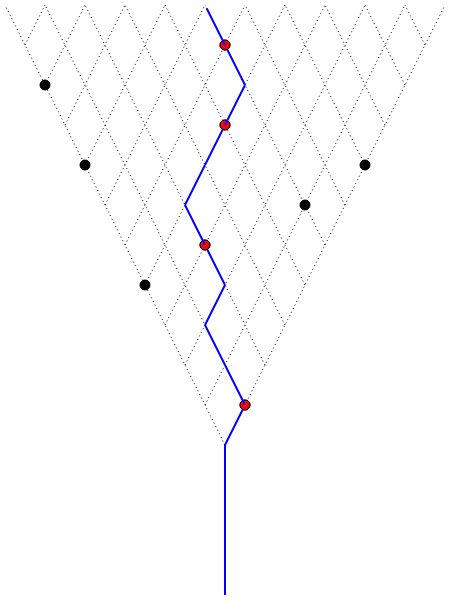
Item 10
